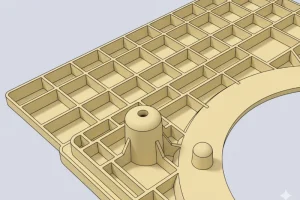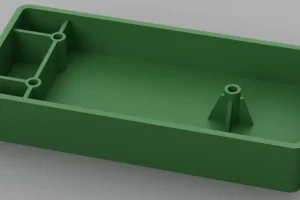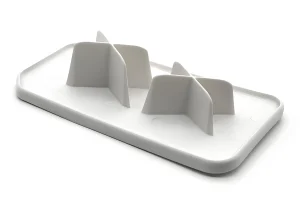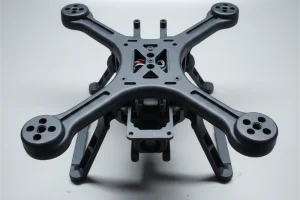Injection molding machines are one of the main pieces of equipment used to make plastic products. They’re used in a lot of different industries, like food, toys, electronics, and medicine. How long an injection molding machine lasts depends on a lot of things, like how you use it, how you take care of it, and how you keep it up. Usually, an injection molding machine lasts about 8-10 years. But if you use it in a really tough place or you don’t take care of it, it might not last that long.
If you use an injection molding machine in a place that’s hot and humid, it’ll rust and corrode, and that’ll make it get old faster. And if the person running the injection molding machine doesn’t get trained or doesn’t use it right, it’ll wear out faster too.

To make your injection molding machine last longer, you should inspect and maintain it regularly, keep it clean, replace worn parts, and use it in the right environment. You can also upgrade your old machine to make it work better and last longer. In this blog post, I’ll tell you about the life cycle of an injection molding machine, what affects how long it lasts, and when you should replace or upgrade it to save money on production and running costs.
Ⅰ.Understand the Injection Molding Machine
1.1 What is an Injection Molding Machine?
The injection molding machine is the main molding equipment for making plastic products of various shapes from thermoplastic or thermosetting plastic using plastic molding molds. It is divided into vertical, horizontal, and all-electric types. The injection molding machine heats the plastic, applies high pressure to the molten plastic, and injects it to fill the mold cavity, then cools and forms.

1.2 Composition of Injection Molding Machine
Injection molding machines typically include an injection system, mold clamping system, hydraulic transmission system, electrical control system, lubrication system, heating and cooling system, safety monitoring system, and more.
1.injection System
The role of the injection system: The injection system is one of the most important parts of the injection molding machine. It generally has three main forms: plunger type, screw type, and screw pre-plasticized type. The most widely used is the screw type. Its function is to heat and plasticize a certain amount of plastic within a specified time in a cycle of the injection molding machine, and then inject the molten plastic into the mold cavity through the screw at a certain pressure and speed. After the injection is completed, the molten material injected into the mold cavity is maintained in shape.

It’s made up of a plasticizing device and a power transmission device.
The screw injection molding machine is mainly composed of a feeding device, a barrel, a screw, a glue passing component, and a nozzle. The power transmission device includes an injection cylinder, an injection seat moving cylinder, and a screw drive device (melt motor).
2.Mold Clamping System
The mold clamping system’s function is to make sure the mold closes, opens, and the product gets ejected. At the same time, after the mold closes, it gives the mold enough force to fight the pressure from the molten plastic going into the mold cavity and stops the mold from opening, which would make the product bad.
The mold clamping system is made up of the mold clamping device, machine winch, mold adjustment mechanism, ejection mechanism, front and rear fixed templates, movable templates, mold clamping cylinder, and safety protection mechanism.

3.Hydraulic System
The hydraulic transmission system is responsible for powering the injection molding machine for all the different actions it needs to perform and for meeting the pressure, speed, temperature, and other requirements of each part of the machine. It’s made up of different hydraulic components and hydraulic auxiliary components. The oil pump and motor are the power sources for the injection molding machine. Different valves control the oil pressure and flow to meet the requirements of the injection molding process.
4.Electrical Control System
The electrical control system and the hydraulic system work together to meet the process requirements (pressure, temperature, speed, time) and various program actions of the injection machine. It is mainly composed of electrical appliances, electronic components, instruments, heaters, sensors, etc. There are generally four control methods, manual, semi-automatic, fully automatic and adjustment.

5.Heating/Cooling System
The heating system is used to heat the barrel and injection nozzle. The barrel of the injection molding machine generally uses an electric heating coil as the heating device, which is installed outside the barrel and detected in sections with thermocouples. Heat conducts through the cylinder wall to provide a heat source for material plasticization; the cooling system is mainly used to cool the oil temperature. Excessive oil temperature will cause various failures, so the oil temperature must be controlled. Another location that needs to be cooled is near the discharge port of the material pipe to prevent the raw materials from melting at the discharge port and causing the raw materials to not be discharged normally.

6.Lubrication System
The lubrication system is a circuit that provides lubrication conditions for the relatively moving parts of the injection molding machine such as the movable platen plate, mold adjustment device, connecting rod hinge, and injection platform, so as to reduce energy consumption and increase the life of parts. Lubrication can be regular manual lubrication. Automatic electric lubrication is also available.
7.Security Monitoring
The safety device of the injection molding machine is mainly a device used to protect the safety of people and machines. It is mainly composed of safety doors, safety baffles, hydraulic valves, limit switches, photoelectric detection components, etc., to achieve electrical-mechanical-hydraulic interlocking protection.
The monitoring system mainly monitors the oil temperature, material temperature, system overload, and process and equipment failures of the injection molding machine , and provides instructions or alarms when abnormal conditions are found.

Ⅱ. Injection Molding Machine Replacement Cycle
The injection molding machine is a kind of production equipment. The recommended replacement cycle of the injection molding machine is about 10 years. During the storage and use of the injection molding machine, if it is found that the performance of the equipment has significantly declined or malfunctions have occurred, the equipment needs to be replaced in time.
2.1 When does the Injection Molding Machine Need to be Replaced?
1.Aging Damage
As the machine gets older, the parts inside it wear out, get old, or even break and stop working right. That’s why you need to get a new machine.

2.Production Requirements
When production keeps growing, or the original equipment can’t meet the production needs of new products, it’s necessary to replace the injection molding machine with a higher power.
3.Technical Update
As science and technology keep advancing, new injection molding machines and technologies will keep replacing the old ones. This means you’ll need to replace your injection molding machines.
2.2 Factors Affecting the Replacement Cycle of Injection Molding Machines
As a type of production equipment, the service life of an injection molding machine is related to the following factors:
1.Equipment Brand and Quality
Good brand and high-quality equipment can definitely extend the service life of the injection molding machine and reduce the replacement cycle.

2.Equipment Care and Maintenance
If you want your injection molding machine to last longer, you have to take care of it.
3.Usage Environment
The usage environment of the injection molding machine is also an important factor affecting its service life. If the use environment is harsh, the temperature is too high or too low, the humidity is too high and other factors will have adverse effects on the equipment and accelerate the aging of the equipment.
4.Frequency of Use and Load
Using the injection molding machine too much and too hard will also make it break down faster. So when you use it, you have to adjust how much you use it and how hard you use it based on how much you’re making.

2.3 The Impact of the Use Environment of the Injection Molding Machine on its Lifespan
1. Temperature
Injection molding machines consume a lot of energy when they are used, so using them in high-temperature environments will cause the machine to wear out faster. At the same time, the oil in the machine will also break down in high temperatures, which will cause more friction in the machine.
2. Humidity
If the injection molding machine is exposed to high humidity for a long time, it is prone to mold, rust and other problems, especially inside the injection molding machine. If it is exposed to moisture for a long time, it is easy to cause electrical components to malfunction, and in severe cases, it may lead to safety accidents such as fires.

3. Cleanliness
The cleanliness of the injection molding machine will directly affect the service life of the equipment. If you use the wrong cleaning agents or methods when you clean the injection molding machine, you will damage the surface of the machine body, which will affect the appearance and performance of the injection molding machine.
2.4 How to Extend the Service Life of the Injection Molding Machine?
In order to extend the service life of the injection molding machine, the following measures can be taken:
1. Do regular maintenance and upkeep on the injection molding machine, like changing the lubricating oil regularly, cleaning the injection molding machine, etc., to make sure the equipment performs well.
2. Use the injection molding machine correctly and don’t overuse or overload it.
3. Keep the injection molding machine clean and dry and don’t let it get wet or hot.
4. Choose an environment and location that meets the requirements for installing and using the equipment, so the injection molding machine can work in a stable environment.

5. Buy good machines: When you buy an injection molding machine, you should choose a reputable brand and a machine that’s guaranteed to be good. Generally, the injection molding machines that these suppliers provide meet the standards.
6. Installing and distributing injection molding machines: Pay attention to the surrounding environment when installing the injection molding machine to prevent accidents.
7. Training employees: Qualified employees can ensure safe operation of injection molding machines and reduce machine damage.
8. Proper use: Use according to the specifications and applicable scope of the injection molding machine. Do not overload the machine or shut it down all year round. Under appropriate circumstances, the injection molding machine can be slowly operated to the rated state.

Ⅲ.Injection Molding Machine Oil Seal Replacement Cycle
Knowing when to replace the oil seals on your injection molding machine is key to keeping it running smoothly and extending its lifespan. But how often should you replace them? Well, that depends on a few things:
1. Usage Environment
Injection molding machines work in different environments, such as high temperature, low temperature, corrosive gases or liquids, etc. Extreme working conditions can cause oil seals to wear out faster, requiring more frequent replacement.
2. Frequency of Use
How often you use the machine affects how fast the oil seal wears out. If you use it a lot, you’ll have to replace it more often.

3. Lubrication and Maintenance
If you keep your oil seals lubricated and maintained, they’ll last longer. Take care of them and they’ll take care of you.
4. Oil Seal Material and Quality
The quality and material of the oil seal will also affect its lifespan. Choosing high-quality oil seal materials and suppliers usually results in longer service life.
Generally speaking, the replacement interval of injection molding machine oil seals is usually between 6 months and 2 years. However, this is only a rough guide and actual replacement times may vary depending on the factors mentioned above. In order to ensure the normal operation of the machine and avoid sudden failures, the best practice is to include regular inspection of the status of the oil seal in the maintenance plan of the injection molding machine, and determine the replacement time based on the inspection results.

Also, if you see oil seal leakage, increased noise, temperature rise, or other weird things, you should check and change the oil seal right away. This will stop the machine and equipment from getting more messed up. You have to do regular maintenance and checks to keep your injection molding machine running good and lasting a long time.
Ⅳ.Injection Molding Machine Modification
Injection molding machine transformation is the upgrade and improvement of traditional injection molding machines to improve their production efficiency and product quality. Injection molding machine transformation mainly includes mechanical and electrical improvements, including hydraulic system, injection control system, temperature control system, operating interface, etc.

4.1 Multi-Faceted Solutions for Injection Molding Machine Upgrades
1. Machine performance upgrades
Motor and hydraulic system of the injection molding machine: Change to high-efficiency motors to save energy and increase production speed and accuracy.
Structure of the injection molding machine: Change to a modular design to make it easier to maintain and replace, reduce downtime; and use new high-strength materials to make it more durable.
Injection system of the injection molding machine: Use advanced controllable back pressure design to make material transportation more reliable and the injection process more accurate.
2. Control system upgrades
Temperature control system: We use a new temperature controller and smart temperature control technology to make sure the materials stay stable and we don’t waste anything when we make stuff.
Injection molding machine control system: We upgraded to a PLC console to make everything more automatic and make more stuff faster.
Data collection and monitoring system: We use sensors to watch everything we do in real time. We can track everything we make and look at the data to make sure we make good stuff and we do it right.

3. Upgrades in processing technology
Mold improvement: Use high-precision processing technology to improve the accuracy and life of the mold, making the product more consistent and beautiful.
Quality control: Use high-precision testing equipment such as radar and laser to conduct non-destructive testing and quality control on products to reduce the occurrence of defective products; implement SPC quality management to further improve product consistency.
4.2 Advantages of Injection Molding Machine Modification
1.Improve Production Efficiency
By transforming, the production efficiency of the injection molding machine can be greatly improved. Improving production efficiency is an effective way to reduce production costs and improve competitiveness.

2.Improve Product Quality
By transforming, we can improve the production accuracy and consistency of the product, reduce the dead corners of the hot runner system, shorten the cooling time, and improve the quality of the product.
3.Improve Equipment Performance
Transformation can enhance the performance of the injection molding machine in terms of injection speed, pressure control, etc., and broaden the application scope of the injection molding machine.

Ⅴ.Conclusion
As the injection molding machine gets older, the parts inside it wear out, get old, or even break and stop working right. That’s the main reason to get a new injection molding machine. As you make more stuff, or the machine you have can’t make the new stuff you want to make, you need to get a bigger injection molding machine. As science and technology keep getting better, new injection molding machines and new ways to make stuff will keep coming out and you’ll need to get a new injection molding machine.
In summary, the life of an injection molding machine varies depending on a number of factors, but generally needs to be replaced after about 10 years. Reasons for replacement include equipment aging, damage, production needs, etc. The specific replacement cycle can be determined based on the actual situation. When replacing an injection molding machine, preliminary research and preparation are required to ensure that the appropriate brand, model, and supplier are selected to ensure the stability and service life of the new machine.

Moreover, daily maintenance of the injection molding machine is even more important. Injection molding machine production usually runs 24 hours a day (shift system) and generally does not stop unless there are fewer orders or public holidays. For machines that have been running for a long time, we must do a good job of maintenance and strive to find and solve problems before the machine breaks down. Otherwise, once the machine breaks down, production must be stopped and repaired, which will seriously affect production and delay delivery. Therefore, it is particularly important to do a good job of maintaining the injection molding machine.










